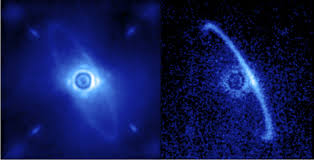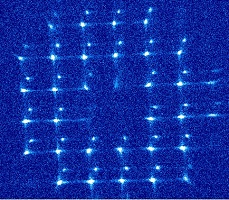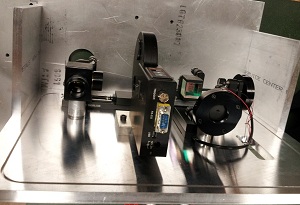Center for Astrophysics and Space Sciences
University of California, San Diego
9500 Gilman Dr, La Jolla, CA 92093
email: jmaire[at]ucsd.edu
Top CV Research Publications
High-Contrast Imaging
Exoplanets, i.e. planets orbiting around a star other than the Sun, are extremely faint light sources compared to their parent star. Light coming from these planets tends to be lost in the glare from their parent star in a way that it is, in general, very difficult to detect and resolve them directly from their host star. Astronomers make use of ground-based telescopes with Extreme adaptive optics systems to correct the effect of light propagating through the turbulent Earth atmosphere, in addition to a coronagraph to block the light of the star, an integral field spectrograph to characterize planet physical properties, and data reduction techniques to reduce noise in images and to improve the capability to detect exoplanets. The Gemini Planet Imager (GPI) is a new instrument that includes all these capabilities (Graham et al. 2007, Macintosh et al. 2014). I've been in charge of developping the GPI data reduction pipeline, during my postdoctoral position at the Université de Montréal (Maire et al. 2010, Maire et al. 2012). It includes reduction of spectroscopic and polarimetric data in the context of high-contrast imaging and improving the detection capabilities by suppressing residual noise (Maire et al. 2012b). GPI has been successfully commissioned at the Gemini South telescope in 2013 and 2014. I'm now working on improving detection capabilities and characterizing GPI photometric performances (Maire et al. 2014).

debris left over from the formation of the system, as seen by GPI in 2014 (GPI cr., Gemini).
High-Angular Resolution Instrumentation
In order to distinguish and to study fine details of observed objects, astronomers want to increase the achievable angular resolution by observing with large telescopes or long-baseline stellar interferometers. Projects to build Extremely Large Telescopes (ELTs), such as the Thirty Meter Telescope, the European Extremely Large Telescope, will give astronomers the opportunity to make major breakthrough discoveries in all fields of astronomy.
Because the achievable angular resolution produced by a ground-based telescope are severely degraded by wavefront atmospheric propagation, telescopes are build with adaptive optics systems to correct the effect of light propagating through the turbulent Earth atmosphere. The design and performances of such systems requires to better know large-scale spatial and temporal properties of light propagation through the atmosphere. My Ph.D. thesis was dedicated to this study. Departure from Kolmogorov model of turbulence has been mesured using a stellar long-baseline interferometer (Maire et al. 2006). We tested experimentally the relevance of different models of turbulence for ELTs (Maire et al. 2008) and we proposed an atmospheric altitude-dependent model validated by atmospheric turbulence profile measurements (Maire et al. 2007).
We are currently interested in developping astronomical facilities close to the North Pole, at the Polar Environment Atmospheric Research Laboratory (PEARL) on Ellesmere Island, where we started our own atmosphere studies.
Ellesmere Island in Canadian High Arctic has been known as a potentially great ground-based observations site due to four months of continuous night, and to its seeing comparable to the one of the best sites, such as Mauna Kea (Hawaii) or Cerro Paranal (Chile). We designed and build a SLODAR (SLOpe Detection and Ranging) instrument (Mieda et al. 2014, Maire et al. 2014c), specifically dedicated to these measurements that we successfully installed on the roof of the PEARL station to assess the quality of the site in terms of astronomical applications.


High-Time Resolution Instrumentation
High-Time Resolution Astrophysics is an important new window to the universe and a vital tool in understanding a range of phenomena from diverse objects, transients, cataclysmic variables, pulsars, X-ray binaries and stellar pulsations. Underlining this science foundation, technological developments in both instrumentation and detectors has been undertaken at the Dunlap Institute in the framework of an unprecedent Near-Infrared SETI project. In addition to these advances that could make a big contribution to our understanding of the Universe, this project intends to search for direct evidence of interstellar communications via pulsed laser signals at near-infrared wavelengths (Wright et al. 2014, Maire et al. 2014a). The new instrument we are building at the Dunlap Institute is the first step toward a new, more versatile and sophisticated generation of very fast optical and near-infrared pulse search devices. This project is a part of the Optical SETI program.


